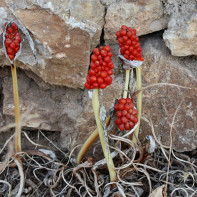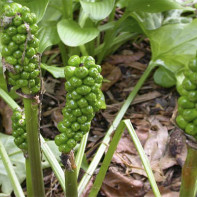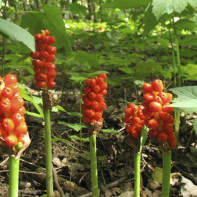Aronnik: medicinal properties and contraindications
Aronnik is considered one of the most striking and mysterious representatives of the large family of Aroidae crops. The plant is widespread, so in different parts of the world it is known under the names: aronica beard, calf leg, arum, dry root.
- Chemical composition
- How it looks and where it grows
- Types
- Gathering and storage
- Medicinal properties of aronnik
- Aronnix spotted in folk medicine
- Infusion for rheumatism
- Remedy for hemorrhoids
- For Boosting Potency
- Ointment for Shingles
- Expectorant infusion
- Leaf poultice
- Remedy for Gout
- Healing Compounds
- Infusion
- Tincture
- Decoction
- Contraindications to use
- Interesting facts
The external attractiveness of aronnik inspires landscape designers and ordinary gardeners to original creative ideas. For this reason, this beautiful plant today is most often used for decorative purposes.
But some alternative medicine practitioners grow it for medicinal purposes, even though it contains a highly toxic substance. Despite its toxicity, arunclea spotted is in demand in the field of homeopathy: it is added in small portions to various preparations intended to treat a huge number of diseases.
Folk healers also prepare ointments, infusions, decoctions from the useful plant according to ancient recipes. The dosage forms are used as an adjunct to basic therapy. They are intended for both internal use and external treatment of skin ulcers and non-healing wounds.
Chemical composition
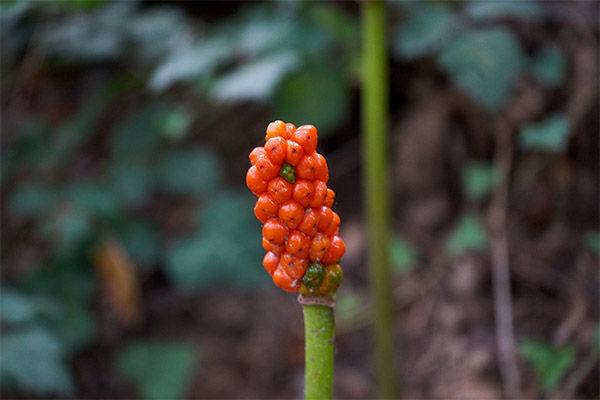
Arum spotted has not attracted the attention of scientists until some time. Therefore, at the moment its chemical composition is poorly studied. But researchers are trying to correct this mistake, and today in different countries this plant is thoroughly studied. Today it is already known for sure that the composition of different parts of the perennial differs in the content of components. Thus, in the tubers of aronnikus the following set of substances was found:
- alkaloids;
- starch (up to 70%);
- aroin;
- saponins;
- glycosides;
- fatty oils;
- fructose;
- trace elements: zinc, molybdenum, nickel, copper;
- linoleic and palmitic acids.
- Arum leaves and fruits are dominated by:
- quercitin;
- oxalic and caffeic acids;
- apigenin;
- rutin;
- luteonin.
It is the content of calcium oxalate and oxalic acid in the leaves of aronnikus, which are prone to rapid crystallization, that causes the formation of thin needle-like formations on their surface. They are very sharp, so during the collection of plant material there is always a risk of damaging the skin. To avoid minor injuries, you must always protect your hands with gloves.
An important point: the poisonous properties of the perennial are due to the active substance aroin and its derivatives. In fresh form, Aronnix spotted is also dangerous because of the content of glycoside-type saponins, which are also highly toxic.
How it looks and where it grows
Outwardly, Arunnikum spotted looks more like a herbaceous plant, reaching a height of up to 60 cm. Other external signs of arum:
- The dense stem of the perennial is quite firmly connected with a powerful root system, which is shaped like hemispheres.
- As it grows, the main root forms adventitious branches that branch off in different directions. Strongly developed underground part allows the plant to be firmly fixed in the soil.
- Leaves. They are the most prominent terrestrial part of the aronica. Large lance-shaped leaves with a network of veins are arranged on the stem in a spiral pattern, and when attached they take on a cone shape. There are a total of 2-3 leaves with stout petioles.
- Flowers. The most striking external feature is the long inflorescence, covered by a leaf-like wrapper on top. Each purple-brown shade of flower is anchored firmly at the flower stalk, allowing the cob inflorescence to form freely thereafter. Arum begins flowering in late April or early May, and in late summer, after the flowers have fertilized, the top of the cob dies off and berries appear in its place.
- The fruits gradually mature and turn a toxic red, and in early fall they all fall off. The ripe berries collected in a bright bunch look very impressive. It is this peculiar peculiarity of spotted arunnik that best reflects its aesthetic characteristics.
Under favorable climatic conditions, arum flowers mature early, and the fruits spontaneously sow in the spring. As a rule, Arunnikum spotted forms only a single inflorescence, appearing at the same time as the foliage.
Interesting fact! During flowering, arum emits an unpleasant smell of rotting meat, which attracts insects. But instead of food, they are trapped. True, the imprisonment of the insects does not last long, but while they are "captive" to the beautiful flower, its pollination takes place. At the end of this process, the threads with pollen fall off, releasing the insects to freedom.
Area of distribution
In the scientific world, it is believed that the Aronica spotted is native to the shady forests of Western Europe. The unpretentiousness of the plant served its wide distribution in other regions of the European part. Today the perennial is found in the North Caucasus, Ukraine and Moldova, feels perfectly well in Abkhazia and Georgia. In the Russian expanses arum can be seen only in areas with a warm climate. The plant does not tolerate low temperatures and dies very quickly from cold. The most favorite places for settling Arunnikum spotted are mixed and floodplain forests with good moisture, shrub thickets. The herbaceous plant prefers clay soils rich in lime.
Today arum spotted is widely cultivated mainly as an ornamental plant. It is propagated by shifts and vegetatively when root tubers are planted in late summer in fertile soil.
Note: Aronnikus must be covered for the winter to give it good protection from the cold.
Types
There are about 30 varieties of aronnikus known today. Most species are used for landscaping in parks, cultural and recreational areas. Some varieties are adapted to living in artificial conditions, and some species of arum can be grown at home and will bear fruit.
But the successful growth of any of the ornamental species requires favorable conditions for the development of the root system and leaves. After all, practically all species of arunnik have leaf platens that are large in size. Among the most common varieties of perennial grass, it is worth noting the most popular cultural and medicinal varieties:
- Aronnix spotted. This is the only species that is used in folk medicine and homeopathy. Of great value in this area are the rhizomes of the plant, rich in nutrients, the main part of which is starch. It is worth noting that despite the poisonous properties of arum berries, wild boars, birds and other forest dwellers do not mind eating them. Wild types of perennial keep their bright fruits on their branches until spring.
- Elongated aronica. This species is found mainly in the middle latitudes, where the climate is temperate. For example, in the forests of Western Ukraine and Moldavia, the perennial feels comfortable among the dense thickets of juniper. This species has very long (up to 20 cm) leaves. This feature is reflected in the name of the species. And sometimes the foliage is so abundant that the purple flowers of the plant are lost in its surroundings. The ripe cobs of inflorescences in the Aronnik elongated retain intact for no more than a week.
- Italian species. This is a very heat-loving variety. Therefore, you should breed Italian aronnik only in places with a stable climate. This variety is characterized by an abundance of leaves and unimaginable length - some specimens reach 70 cm. However, such giants are found at the base and the foliage is shorter at the top. As the inflorescence matures, the leaf plates take on a creamy hue.
- Oriental Aronian. This representative of the Aroidea family is not tall. It likes to settle in the shade of oak forests that still remain in Europe. On the plains of Hungary and Austria you can also find individual individuals of the oriental arum. The length of the leaves of this species of perennial does not exceed 25 cm, but its flower stems are twice as large as this indicator.
- Common arrowroot or tarragon. This giant species in favorable conditions reaches over a meter of growth. The oval-shaped tubers also have impressive parameters. In the wild, the common arum occurs in the forests of the Caucasus and Europe. The flowers of this species are distinguished by their brown color.
- Cretan species. As its name suggests, this heat-loving variety likes places with a moderately stable climate. Unlike its family members, the Cretan variety has arrow-shaped leaves that can be up to 50 cm long. It is the most beautiful of the ornamental varieties: the dark green foliage complements the purple berries, creating a harmonious natural picture.
- Besser's variety. Representatives of this species prefer a solitary existence. Occurs in Poland, the Caucasus and Central Europe. A low-growing plant with wiry leaves during the flowering period is literally covered with single-sex flowers of purple hue. But despite the beauty, the inflorescences emit a pungent, unpleasant smell that scares away birds and animals.
- White-winged aronica. This incredibly beautiful plant grows in the Crimea and some regions of Asia Minor. The peculiarity of this species is that the leaves appear after the flowering and fruiting period.
Gathering and storage
As a raw material for medicinal compositions, the rhizomes of aronnik are harvested. They are collected before the appearance of leaves or in late autumn. But herbalists advise to harvest valuable material exactly in September, because by this time they have a high concentration of active compounds.
Collection rules
- Dig out the tubers carefully.
- Peel from the woody crust, which by autumn is formed on the surface of the roots.
- Cut into pieces.
- To avoid rotting, spread the raw material in a thin layer on a cloth or paper sheet.
- Dry the plant material in the shade, better under a canopy in the open air.
Although the leaves are very rarely used in folk medicine, the need for them arises when you need to prepare effective compositions for external treatment. Always wear gloves when picking fresh arum greens to avoid minor injuries. The harvested "crop" is dried as described above. From dry leaves prepare decoctions, because under the influence of high temperatures poisonous substances volatilize.
How to store
Fresh roots arum store in boxes with sand in a cellar or basement. Periodically you should monitor the condition of the tubers. It is important to give them such conditions that they do not begin to sprout. Since this is difficult to do, herbalists advise drying the roots. In this form, the raw material is stored without loss of medicinal qualities for up to two years. The ideal container for dried roots - a glass jar with a lid.
Medicinal properties of aronnik
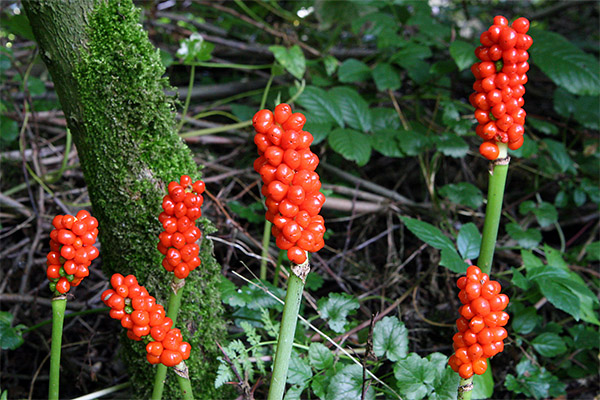
Due to its high toxicity, Aronnik spotted is not included in the State Pharmacopoeia of the Russian Federation. But in folk medicine, this useful plant, although not very widely, is used. Properly prepared raw material is an excellent basis for infusions, decoctions, ointments. Easy to prepare medicines have a whole complex of therapeutic properties:
- anti-inflammatory;
- expectorant;
- analgesic;
- anthelmintic;
- wound-healing;
- antibacterial;
- antiemetic.
It has been proven that in the composition of the herbaceous plant there are substances that reduce the acidity of the gastric secretion.
This is interesting! Given that any poison in small doses can be an effective medicine, homeopaths prepare on the basis of arum, which is in great demand among people with respiratory and vocal cord problems. Many vocalists and speakers specifically take Arum before speaking to eliminate hoarseness.
In what pathologies Aronnikum spotted is useful:
- Respiratory infections;
- laryngitis;
- parotitis (mumps);
- sciatica;
- rheumatism;
- toxicosis in pregnant women;
- Wounds and ulcers on the skin surface;
- impetigo;
- hemorrhoids;
- digestive disorders;
- microsporiasis;
- shingles;
- helminthiasis;
- diseases of the urinary system.
Aronnik is effective for common runny nose and sore throat. It is often used for rapid recovery of patients after surgery.
Useful to know! Some gourmands fry and boil arum roots, considering such a useful addition to the diet.
Aronnix spotted in folk medicine
As already noted, mainly for the preparation of preparations according to folk recipes are used the roots of Aronnix spotted, less often - the leaves. The berries are not suitable for the preparation of compositions because of their poisonous nature. Here are a few recipes for practical use as an example.
Infusion for rheumatism
The preparation relieves painful sensations and eliminates signs of inflammation. The healing solution is prepared by insisting 50 g of dried roots of arum in 2 liters of water. The infusion must stand for at least 8 hours, then it should be taken according to this scheme: starting with 1 drop, gradually increasing the dosage to 10 drops per reception. Such an infusion is suitable for the treatment of internal hemorrhoids and urolithiasis.
Note: You need to strictly adhere to the recommended doses, otherwise you can not avoid side effects.
Remedy for hemorrhoids
Dry roots of aronnik must first be passed through a meat grinder. Then crushed raw materials in the amount of 40-50 g pour a liter of water. Put the solution in a dark place for infusion. After 12 hours, you can start treatment according to the same scheme described in the previous recipe.
To improve potency
This recipe will help men to improve sexual performance. A composition is prepared from dried arum leaves (1 tbsp) and good grape wine. You can use for this purpose a drink prepared by your own efforts. Tincture stand for 7-10 days, then take it in small portions (1 tbsp) to increase sexual power.
Salve for herpes.
A very effective remedy that helps even in neglected cases. Shredded roots of aronnik mixed in equal quantities with honey. Insist the drug for a day. The composition is designed to treat the affected areas of the skin. After application, leave the ointment for 10 minutes, and then wash it off. This recipe is suitable for the treatment of impetigo.
Expectorant infusion
This recipe should be used for bronchitis, if the cough is unproductive. The composition is prepared according to a similar scheme: per liter of water, 1 tbsp. of crushed roots of chokeberry. Insist the medicine overnight. Be sure to filter the solution before use. An adult patient to drink a third of a glass at a time, half an hour after a meal. The same composition can be drunk with nausea. Only in this case, a single dose - no more than 50 ml.
Leaf poultice
Such a procedure will help with inflammation of the sciatic nerve or malignant ulcers on the skin. A fresh leaf should be steeped in boiling water, and then quickly applied to the problem area.
A cure for gout.
Also this recipe will help with muscular myalgia. To treat these diseases, a tincture of arum roots in vodka is prepared. Fresh plant material and dried raw material will be suitable. Proportions: for 20 g of roots - a glass of vodka. It is best to use a bottle of dark glass. After two weeks of aging, take the finished medicine in a drop at a time. The resulting tincture can be used for compresses with spurs.
Types of medicinal compositions
In principle, the ways of preparing medicinal forms on the basis of the roots of aronnika are described above. But each individual recipe has its own nuances. Therefore, let's dwell on the classic options for making liquid medicines on the basis of this healing plant.
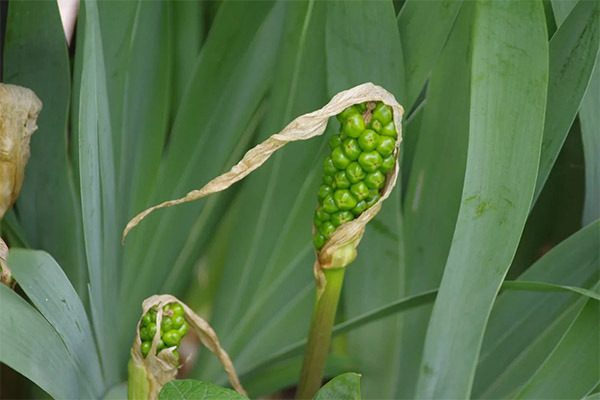
Infusion .
Aqueous infusion is most often used for therapeutic purposes. Different recipes specify different dosage. According to the classic recipe, an aqueous infusion is made of 1 tsp. finely chopped roots and a glass of water. Standing time of the infusion - at least 8 hours. Before use, strain the solution. Such a medicine, if the doctor allows, can be drunk by pregnant women with early toxemia. The optimal dose - a quarter cup. It is desirable to drink the medicine in small sips.
Tincture .
Traditionally, herbal tinctures are prepared on an alcohol base. If the base component is 70% purified alcohol, then the formula 4:1 is applicable. One part accounts for the dried crushed roots. Put the container in a dark place for a week, periodically shaking the solution. When the medicine is ready, strain it. Take on an empty stomach three times a day for 10 drops. If you feel well, you can increase the single dose to 15 drops.
Good to know! Alcoholic tincture of arum root on grape wine helps with malignant tumors in the nose.
Decoction
Decoction of arum root helps in the treatment of colds. Such a drink is recommended to drink hot, in small sips up to 5 times a day for acute symptoms. A single dose of 1-2 tbsp. before taking the drug dilute with pure water in a ratio of 1:1.
The course of taking all the medicinal liquid forms is designed for a month. It should be noted that decoctions are used very rarely due to the fact that during heat treatment the composition loses most of its useful components.
The greatest therapeutic effect is given by the use of alcoholic tincture of the herb aronnik.
Contraindications to use
To exclude the risk of poisoning and other side effects, aronnik spotted should be used for therapeutic purposes only after agreeing with your doctor. This is especially true for pregnant women, who with the help of the healing plant want to solve the problem of toxicosis. The list of absolute contraindications includes:
- Age under 16 years of age;
- Breast-feeding period;
- pancreatitis;
- second half of pregnancy;
- heart failure;
- gastritis with low acidity;
- individual intolerance;
- The presence of chronic pathologies of the cardiovascular system.
Failure to comply with the rules of admission and the specified dosages can lead to the most severe consequences up to cardiac arrest. Intoxication when poisoned by the herb of aronnik is accompanied by intestinal disorders, arrhythmia, hallucinations.
Interesting facts
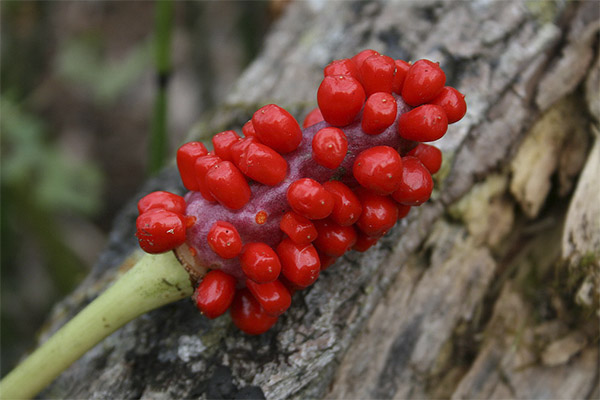
- Despite the poisonous properties of arum, in the Middle Ages European healers widely used it to treat tuberculosis, pneumonia and hoarseness of the voice.
- It was common in those days to apply the fresh root to paralyzed parts of the body. It was believed that arum spotted was able to return mobility and sensitivity to the limbs.
- In ancient times, wounds received by warriors in battles were powdered with arum root powder. We must pay tribute to the effectiveness of this method. Wounds really healed quickly.
Arunnik is a very beautiful and useful plant. But we must remember that this representative of the flora requires a respectful attitude. If you want to use it with a therapeutic purpose, you must necessarily take into account contraindications and possible risks.
«Important: All information on the site is provided solely for introductory purposes only. Before applying any recommendations, you should consult with a specialized specialist before using any of the recommendations. Neither the editors nor the authors shall be held liable for any possible harm caused by materials."


